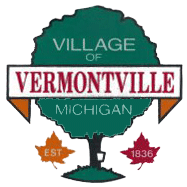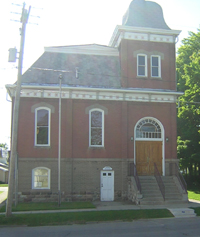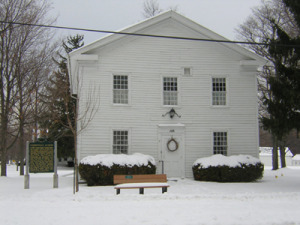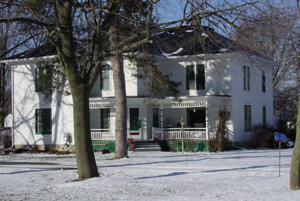About Vermontville
The Village of Vermontville was established in 1836. It is the home of the original Annual Maple Syrup Festival. The Village has a population of approximately 759 people, and it covers 1 square mile. Our village has adopted a Village Master Plan, Village Zoning Ordinance, and a revised Village Code of Ordinances, all since 2002.
History of our Village and its Buildings
No other town or city in Michigan can compare with Vermontville as to the unique manner in which it was founded. While other town’s came into being by chance, usually influenced by some geographical advantage, Vermontville was the result of careful planning and the plans were made hundreds of miles removed from the forested wilderness that was destined to become a town.
It was in the fall of 1835 that Reverend Sylvester Cochrane, a Congregational minister from East Poulney, Vermont, visited Michigan with the idea of locating here permanently. He found settlers so scattered that it was difficult to organize schools or churches and there was born in his mind the idea of starting a sizeable colony, which could from the start, enjoy much the same cultural advantage existing in New England. The Reverend Cochrane returned to Vermont and sold the idea to his friends and neighbors.
There were numerous meetings of families interested in emigrating to Michigan and finally, on March 27, 1836 at Castleton, Vermont, rules and regulations were drawn up for what was to be called the Union Colony. There were plenty of “whereases” and some twenty rules and regulations, but the manuscript even today stands as a remarkable example of concise and intelligent planning. Some of the more important provisions were:
* A committee of two was set up to pass on the worthiness of applicants for membership in the colony. A committee of three was named to journey to Michigan to explore and purchase land for the Colony, buying three square miles or 5,760 acres and as much more as the collective funds would permit.
* The land was then to be laid out in farms of 10 acres each and each member of the Colony then would be entitled to the sum of $212.50 paid in advance to one farm lot of 160 acres and one town lot of 10 acres. Persons unable to raise that money could pay $106.25 and settle for 80 acres of farm land and a five acre lot in town. There also was a provision for a member to give his note in lieu of payment, for a period of three months.
* Each settler, when receiving a deed to his village lot, was to give a note to the Colony for $25.00, payable in two years, and the Colony was to use the money towards defraying the expense of building a meeting house. An 80 acre lot was to be reserved for a parsonage.
On April 2, 1836, S.C. Church and William G. Henry left Vermont with the Colony’s money in a cowhide valise. In, western New York they were joined by Walt J. Squier, one of the Colonists, and the three made their arduous journey west by way of Buffalo and Detroit, reaching Battle Creek more than a month from the time they left home. Squier and Henry went on to Kalamazoo and made side trips exploring unclaimed land, while, Mr. Church did likewise in other unsettled areas.
After several weeks of this the three men met and talked things over. The situation seemed discouraging. They had explored Barry County as far as Middleville, as well as parts of Ionia and Kalamazoo Counties, and had found no suitable areas of sufficient size and excellence to suit the needs of the more than thirty Colonists they represented. Then Mr. Church met Colonel Sarnes of Gull Prairie, who had just finished surveying Eaton County, and the Colonel took him to the state land office and showed him what he claimed was a me area at the western border of Eaton County. In the entire township only one plat had been taken.
The three agents for the Colony, along with several other colonists who had arrived in Battle Creek from Vermont, made the trip to the present site of Vermontville, taking two days to push their way through the wilderness between Bellevue and their destination. They spent another day inspecting the area and liked what they found. A few days later in Kalamazoo they completed the purchase and then returned to the site and laid out the village according to rules and regulations of the Colony. W.J. Squier, W.S. Fairfield, Samuel and Charles Sheldon, Levi Merrill, Charles T. Moffitt, and several others stayed and commenced chopping and clearing land, while Mr. Church, early in June, started back to Vermont to make arrangements for removing his family.
During the summer Beezaleel Taft moved in with his family. Reuben Sanford, who had bought land adjoining the Colony, arrived with his wife and small son and shortly afterward his wife gave birth to a second son, who was the first white child born in the settlement. During the fall the Jay Hawkins, Jacob Fuller, and Elijah Fuller families arrived. Mr. Church, who is responsible for much of the written history of the Colony, arrived in November of 1836 with his wife and six children.
Wolves were numerous and constantly raided hen roosts and pig pens, but never harmed humans. Bear also were plentiful and in 1839 when a big black bear had exhausted the patience of the settlement by frequent raids on livestock, all the men and boys turned out and hunted him down. The bear skin was sold for $4.00, which was used to start a Sabbath school library.
During the early years of the settlement Indians were common. Members of the Pottawatomie tribe lived in the area and without exception they were friendly. The former Vermonteers found the Indians each spring in one of Vermont’s most common practices, that of making maple syrup from the sap of the hard maple. The sugar season in 1837 was excellent and the following year found some of the colonists taking maple sugar to Battle Creek for sale. In the years since, the product, eventually largely replaced by maple syrup, has remained an important cash crop throughout the area.
The Village of Vermontville was incorporated, along with hundreds of villages in the state by an act of the Legislature, March 11, 1867, by Orin Dickinson, William Parmenter, John L. Hunter, and seventeen others. Church’s Addition was laid out September 6, 1869 by Eliza Church, and Squier’s Addition was laid out November 8, 1869 by Martin L. Squier. After the village was incorporated Davis and Parmenter’s Addition was laid out in 1877.
Early in the history of Vermontville, Wells R. Martin started the first hotel. In 1855 James Tufford built the New England Hotel, which later became known as the Follett House and which for many years was ably managed by S.A Gunn, a native of Ashtabula County, Ohio.
Tavern owner, Wells Martin, in partnership with Deactur Scoville, also started the first store in Vermontville; freighting in merchandise from Bellevue and selling it from his home. The first regular store was started in 1846, when Hale and Frink opened a place of business on the first floor of the Academy building.
Within a few years after the settlement was started S. S. Church brought in the first mail over a route which was established from Bellevue to Ionia. A post office was established at Vermontville about 1840, with Dr. Dewey H. Robinson acting as postmaster. Mail was brought through on horseback once a week.
In the spring of 1874 Vermontville’s first newspaper, the Enterprise, was started by I.C. Worcester, who later sold to G.W. Hoskins. Mr. Hoskins sold to K. Kittridge, who later sold to Captain F.W. Potter. The Vermontville Echo today represents an unbroken record of more than 80 years, during which time the publication has changed its name from Enterprise to Hawk to Echo.
The Colonist who founded Vermontville came prepared to carry on the church and school systems they had known in their native Vermont. In February 1837, they organized the Congregational Church with the Reverend Sylvester Cochrane as pastor. The history at the church would make a book length story in itself.
In 1844 the Methodist Episcopal Church was organized here by the Reverend Samuel Noble at the Red Schoolhouse in District 2, and in 1862 a church building erected at a cost of $2,400.00 over a period of nearly two years, was formally dedicated. As early as 1878 the Free Methodists had begun holding meetings in the village but did not have a regular place of worship.
The first school in Vermontville was established in the summer of 1828 and was held in various private homes. That fall a log school house was erected and about seven months of school was held each year, with a woman teacher during the summer term and a man teacher in the winter. During the winter term enrollment was more than doubled, with many grown men and women attending.
By 1843 the population had so increased that an association was formed and plans made for building an academy, to serve both as a church and a school. In the fall of 1844 the building was completed and the Reverend R.D. Benedict, pastor of the Congregational Church, taught a four month term of school in which “the higher English branches and also the languages” were offered. In the 1860’s the Academy, which was comparable to the present day high school, was combined with the district school and a union school, with two departments, was set up in the academy building. In 1869 voters in the district approved plans for building a new union school and in 1870 the building was put up at a cost of $12,000.00.
History of the Opera House
Construction on the Opera House was started in either 1893 or 1896 and completed in 1898. It is a two-story red brick structure with a cut stone foundation and an off-center tower over the front entrance. It also has a balcony, coat check room and a box office for ticket sales.
The Opera House was built to replace the building that had been used for village and township business and various forms of social events. The first building burned in 1896. The village financed the first story of the Opera House and the township financed the second story.
As the building neared completion, three local men, Charles Fleming (a shoe dealer), E.D. Barber (a hardware merchant) and W. C. Alsover (a cashier at the local bank), suggested including a large stage with wings, scenery and a curtain so that stage plays could be held. The three furnished the funds to complete this project. Their investment was paid off later from proceeds from the plays.
It was from the Opera House stage that L. Verne Slout, a hometown boy, first presented his Slout Players who toured several states for years and won recognition as Michigan’s oldest tent show company. In 1953 he took his final bow after a thirty-year career.
Fire Department equipment was stored in the east end of the building for many years. In the early 1960’s the size of the new fire trucks made it necessary to build a more modem fire barn across the street.
The west end of the first floor houses the Mildred Allen Memorial Library and, when the new fire barn was built, the library expanded to utilize the space to the east. The village and township offices were also moved to new locations in the Opera House.
The Opera House was used for traveling medicine shows, graduations, roller skating, Boy Scout meetings, free movies, dances, religious services and other social events. It is still used for stage plays and various other events such as amateur night and the crowning of the Maple Syrup Festival queen in case of poor weather.
On Apri1 30, 1978 the Opera House was dedicated as a Michigan Historical Building by Jerry D. Roe, Michigan Historical Commissioner. New front steps were installed in 1985. Since then other refurbishment has been done, including the front doors stripped and refinished, new kitchen, the floor refinished, new draperies and stage lighting (funds donated by the Vermontville Women’s Club), heating and cooling, and painting.
History of the Vermontville Chapel and Academy
The Academy/Chapel, which is now the Vermontville Museum, remains the property of the First Congregational Church. In a larger sense, however, it belongs to the entire community.
The construction of the Academy appears to have taken place because Rev. Sylvester Cochrane, spiritual leader of the union Colony, asked his parishioners to “build a house in which we may instruct our children and worship the Lord.”
In 1843, only five years after the First Congregational Church was organized, the members procured materials and raised funds by subscription to erect on the northwest corner of the village square a two-story building. It was to serve as both an academy and church.
The simple 30′ x 40′ frame building has a white clapboard exterior. Its gabled roof (originally shingled but now covered with sheet metal) and the modified Greek cornice reflect its origins in the early national period.
With the completion of the upper floor in the fall of 1844, the Rev. W. U. Benedict, the second pastor of the church, started teaching the higher branches of English and languages. Not only was the Academy the local institution of learning until the union School opened in 1870, it was also a highly respected center of learning in Eaton and surrounding counties until Olivet College became well established.
Rev. Benedict organized the ladies of the church into a society which for years had the welfare of the Academy/Chapel at heart. Their earliest endeavor was the purchase of the Academy’s windows. Each window consists of sixteen panes which make them unusual today.
In 1847 the ladies purchased the first bell to be used not only for summoning worshipers to church services and students to classes but also for alerting villagers to important happenings. According to a diary kept of the day, its tolling announced the death of President Lincoln in 1865. The bell was later sold to the union School District but was returned to the Chapel when the school was torn down. Church services were held in the chapel until the present First Congregational Church was dedicated in November, 1864.
In 1900 the outside stairs were added to the Chapel and a storage room on the back. In 1904 the kitchen was enlarged and the upper floor was furnished as a dining room. within a few years improvements were made to the lower level which became an attractive parlor. Prior to the construction of the Opera House it was the site of the annual Township Meetings.
In 1966 the newly organized Vermontville Historical Society received permission from the church board to use the building as a museum. The building was officially opened to the public as a museum during the 1967 Maple Syrup Festival.
On June 7, 1970 a bronze plaque was placed to the south of the building by the Michigan Historical Commission designating it as a Historical Landmark Building. In 1972 it was placed on the National Registry of Historical Buildings.
In 1976, in response to a joint appeal from the church and the Historical Society, financial assistance was obtained from friends and descendants of many pioneer families to begin an extensive restoration project. The original pine floor was replaced with a new one and the foundation was strengthened in order that further work might be continued at a later date. During the summers of 1982 and 1983 work was resumed and the upper floor was leveled and carpeted. The walls were paneled and a new fire escape was added.
History of the Angel House
On September 1, 1843 William Uriah Benedict, the second Congregational minister in Vermontville, purchased the land where this home is located. The property remained in the Benedict family until 1920 Glenn and Beulah Lake assumed ownership and later sold the home to Edmund and Ina Sprague in January 1925. The Spragues sold the property to Dr. L. D. and Hildred Kelsey in 1939. Mrs. Kelsey-Peabody resided in the home until her passing in 2004. This home is now owned jointly by the Kelsey children and occupied by Douglas Kelsey.
The house is very well built and its cherry log beams are in excellent condition. On the south side of the home there is a bay window extending two stories. The eastside of the house has a similar window. The home has five picture windows which is unusual for a house built in the middle 1800’s. In the late 1880’s or 1890’s Sarah B. Williams, the daughter of Rev. Uriah Benedict and an artist, painted a mural in oils in the east bedroom on the second floor for her daughter, Alma. The mural is painted on plaster on the dropped part of a double ceiling. The painted portion, which is approximately 12 inches wide, has cupid-like angels cavorting in the grass and flowers. The angels are beautifully colored and the grasses and flowers are natural looking. One little angel is fully clothed and is said to represent the daughter, Alma.
Alma later married Dr. Lester Swinton, whom she met at Olivet College, and they moved to Ontonanagon where he practiced for many years serving the mining and lumber camps. After his death, she moved to Marquette. When she was in her middle eighties she took a course in creative writing at Northern Michigan University. In the Mildred Allen Memorial Library there is a copy of her book, “I Married a Doctor”, which tells of her experiences assisting her husband in treating the accidents that occurred in the camps. Also in the library are two paperbacks by Mrs. Swinton, “Tales My Mother Told Me”, and “Teen and Tales”. Mrs. Swinton was also a piano teacher for many years. She was also President of the Michigan Federation of Music Clubs and is noted for her work and support of Interlochen Music Camp. There is a music scholarship in her memory at Northern Michigan University. She passed away in Marquette on April 25, 1965.



